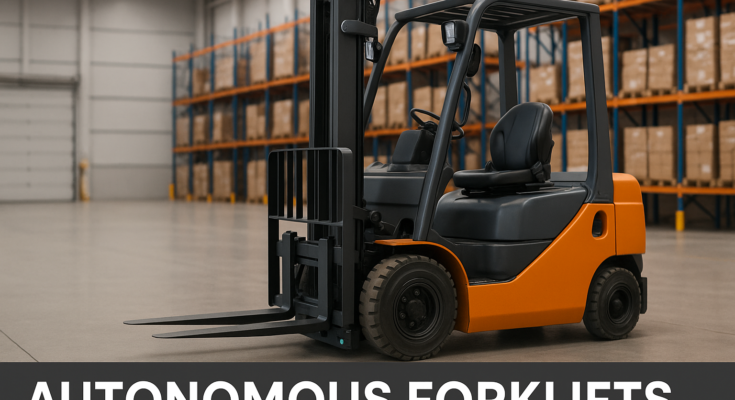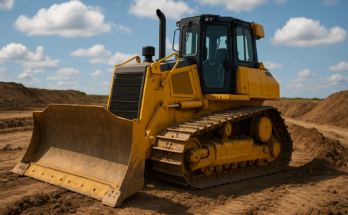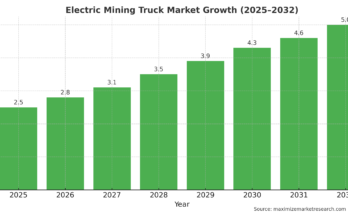The Global Autonomous Forklifts Market is undergoing a significant transformation, projected to grow from USD 4.61 billion in 2024 to approximately USD 7.99 billion by 2032. This growth represents a compound annual growth rate (CAGR) of 7.1% during the forecast period, highlighting the industry’s pivotal role in reshaping material handling systems worldwide.
Global Autonomous Forklifts Market Estimation & Definition
Autonomous forklifts are advanced driverless material-handling vehicles that utilize onboard software, sensors, and navigation systems to perform logistics operations. These vehicles are engineered to carry out tasks such as lifting, transporting, stacking, and storing goods in warehouses or production facilities with minimal human intervention.
Unlike traditional forklifts that require manual operation, autonomous forklifts function through intelligent programming, real-time mapping, and automated route selection. They not only increase operational efficiency but also enhance safety, reduce costs, and offer scalability for large and small enterprises alike.
In 2024, the global market valuation stood at USD 4.61 billion. Over the next eight years, it is forecasted to reach USD 7.99 billion, owing to increasing adoption across industries such as manufacturing, warehousing, logistics, and freight management.
Global Autonomous Forklifts Market Growth Drivers & Opportunities
Labor Shortage and Rising Wages
One of the most significant factors influencing market growth is the shortage of skilled labor and the rising costs associated with workforce management. Warehousing and logistics companies across developed and developing regions are turning to automation to address labor constraints, reduce training requirements, and improve consistency in operations.
Booming E-Commerce Sector
The surge in e-commerce activity globally has placed immense pressure on supply chains to be more agile and accurate. Autonomous forklifts help meet this demand by enabling 24/7 operations, reducing turnaround time, and improving order accuracy. Faster product movement from storage to dispatch becomes feasible with minimal human intervention.
Focus on Safety and Efficiency
Workplace safety continues to be a key area of concern, particularly in industries involving heavy material handling. Autonomous forklifts significantly reduce human error and workplace accidents, ensuring safer operations. Additionally, they improve energy efficiency and lower product damage, leading to cost savings in the long run.
Technological Advancements
Advances in artificial intelligence, machine learning, LiDAR, and robotics have accelerated the development and deployment of autonomous forklifts. These machines now feature enhanced navigation, real-time decision-making, adaptive obstacle avoidance, and improved fleet coordination.
Growth in Leasing Models
Leasing and subscription-based forklift models are gaining popularity, particularly among small and medium enterprises (SMEs), as they reduce capital investment while allowing companies to upgrade systems quickly and efficiently.
Global Autonomous Forklifts Market Segmentation Analysis
The Autonomous Forklifts Market is segmented across multiple categories, allowing manufacturers and service providers to address specific operational and industry needs.
By Component
-
Software – Fleet management systems, navigation platforms, and real-time mapping software are crucial to the intelligence of autonomous forklifts.
-
Hardware – Includes forklift chassis, embedded sensors, cameras, LiDAR, and computing units.
-
Services – Covers installation, maintenance, customization, and system integration services.
By Application
-
Freight & Logistics – Used for fast-paced movement of goods in logistics centers and ports.
-
Manufacturing – Supports production line material flow, work-in-progress inventory movement, and assembly line supply.
-
Warehousing – Plays a central role in stock management, loading/unloading, and order picking.
-
Others – Includes agriculture, pharmaceuticals, and food & beverage industries.
By Tonnage
-
<5 Tons – Compact forklifts suitable for lightweight loads and narrow aisles.
-
5–10 Tons – Medium-capacity units suitable for broader warehouse applications.
-
>10 Tons – Heavy-duty forklifts designed for industrial use and large-scale operations.
By Sales Channel
-
Leasing – Flexible options allowing businesses to deploy modern forklift systems without major upfront investments.
-
In-House Purchasing – Traditional ownership model preferred by large-scale operations.
Global Autonomous Forklifts Market Country-Level Analysis
United States
The U.S. remains the largest autonomous forklift market in North America. Factors driving growth include:
-
High demand for advanced warehouse automation systems due to e-commerce fulfillment growth.
-
Significant labor shortages in logistics and supply chain roles.
-
Increased safety regulations encouraging the shift to automated and predictable operations.
-
Wide adoption across third-party logistics providers, retail chains, and manufacturing hubs.
The market also benefits from government incentives promoting the integration of intelligent systems into industrial operations.
Germany
Germany, recognized as an industrial leader in Europe, is seeing accelerated adoption of autonomous forklifts, particularly in the automotive, mechanical engineering, and manufacturing sectors.
Key drivers in the German market include:
-
A strong culture of industrial automation and smart factory integration.
-
Highly structured warehousing systems that benefit from seamless robotics coordination.
-
Emphasis on energy efficiency and high productivity in logistics operations.
-
A robust mid-sized enterprise (Mittelstand) base that actively adopts cost-saving innovations.
Germany also acts as a gateway to broader European Union markets, encouraging domestic and international investment in forklift automation solutions.
Global Autonomous Forklifts Market Commutator (Competitive) Analysis
Competitive Rivalry
The autonomous forklifts market is highly competitive and features a mix of long-established players and agile tech-driven startups. Major companies are investing in R&D and software-platform partnerships to maintain market share and innovate on design, usability, and integration.
Supplier Power
Suppliers of critical components such as LiDAR, sensors, and software platforms wield moderate influence. However, the increasing availability of off-the-shelf systems is reducing overall supplier dominance, especially in modular integration environments.
Buyer Power
End-users ranging from small warehouses to multinational supply chain operators have increasing purchasing power, driven by expanding options and a broader understanding of automation ROI. Enterprises are seeking customized solutions with rapid payback periods.
Threat of Substitutes
While traditional forklifts and semi-autonomous vehicles still operate widely, their inability to match the efficiency, speed, and adaptability of fully autonomous models makes them less favorable for future-forward operations.
Threat of New Entrants
Technological advancement and demand-side pull have lowered entry barriers. New market entrants are leveraging cloud-based solutions, AI capabilities, and robotics-as-a-service models to gain market presence. However, long-term success depends on scalability, safety certifications, and integration support.
Global Autonomous Forklifts Market Conclusion
The global autonomous forklifts market stands at the forefront of industrial automation. With a projected rise from USD 4.61 billion in 2024 to USD 7.99 billion in 2032, the market’s evolution is being fueled by the need for speed, accuracy, cost control, and safe logistics operations.
As industries across the globe shift toward intelligent warehousing, autonomous forklifts are playing a vital role in bridging productivity gaps, reducing human error, and delivering performance consistency. The growing appeal of leasing models, combined with rapid technology adoption, is ensuring that businesses of all sizes can access next-generation material handling capabilities.
Market players that emphasize system reliability, integration readiness, and tailored customer solutions will be well-positioned to lead the next wave of warehouse automation.
read More:
https://researchmaximize.com/global-automotive-smart-tire-market-size/



